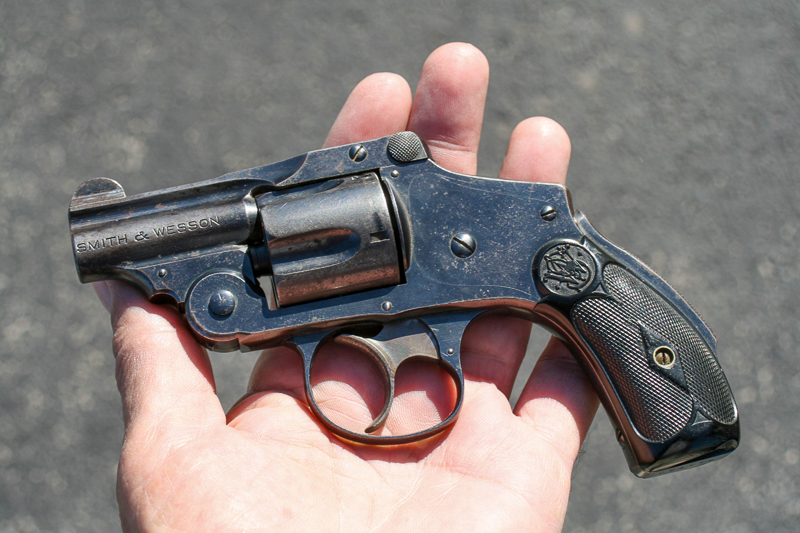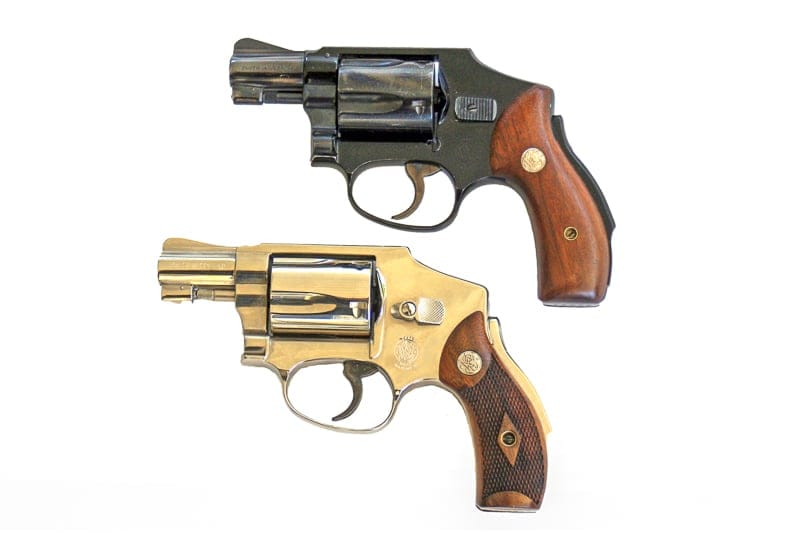The last time I asked the folks at Smith & Wesson, I was told that their best-selling revolver was the “hammerless” J-frame snubby introduced in 1952 as the Centennial (since that was their hundredth year in business). The gun has a helluva history behind it…and its popularity today is due to solid performance features that went unrecognized for a very long time.
Let’s look at the background first.
A Brief History
In 1887, Smith & Wesson introduced their New Departure Safety Hammerless revolver, a five-shot top-break offered in calibers .32 and .38 S&W. The design was quickly copied by Harrington & Richardson, Iver Johnson, and just about any other manufacturer of economy-priced top-breaks.

The legend says that one of the company’s founders, Daniel Baird Wesson, was appalled by a case of a child being killed when he got hold of his parents’ conventional revolver. Wesson set out to design a child-proof handgun. The cardinal feature would be a concealed hammer that could not be reached by the user and, therefore, could not be cocked to an easy single-action trigger pull.
Another feature would be a grip safety which, at least in theory, would require an adult hand to depress before the weapon could be discharged. The grip safety would earn the revolver a nickname with the gun-buying public: the “lemon-squeezer.” Finally, the trigger pull would not only be long but heavy, at least theoretically so heavy that a child could not pull it all the way back.
Legend also says that Mr. Wesson confidently handed a loaded “lemon squeezer” to a child and challenged him to fire it and that the kid promptly pumped a round into the floor in front of Wesson. I say “legend” because there’s some question whether or not the story is true. In any case, the New Departure Safety Hammerless proved popular enough to remain in the Smith & Wesson catalog until shortly before World War II.
Long-Lasting Popularity
During those many decades, the gun was popular for concealed carry, primarily because without a protruding hammer spur, it was snag-free when drawn from a pocket or other place of deep concealment. One gun expert who appreciated that feature was Col. Rex Applegate of WWII OSS fame, who became a Smith & Wesson representative in Latin America after World War II.
In the hot weather there, he carried a Safety Hammerless .38 in an upside-down shoulder rig under his shirt, and the day came when he was attacked by a madman with a machete. He pumped all five .38 S&W rounds into the man who kept coming. According to various accounts, the attacker was finally put down by one of Rex’s colleagues with a .45. The attacker ended up dead, and Rex ended up unscathed and thoroughly disappointed with the anemic performance of the stubby little .38 S&W round.
When S&W introduced the little J-frame Chief Special in 1950 — a short barrel five-shot .38 Special on a .32 frame — Applegate used his influence with S&W CEO Carl Hellstrom to convince him to make a variation that was hammerless like the New Departure.
The Centennial was born, appearing first in Airweight configuration in 1952 with an aluminum frame and subsequently in an all-steel variation. In the late 1950s, when S&W went to numeric designations, the all-steel Centennial became the Model 40 and the Airweight, the Model 42. The grip safety remained, but these guns came with a removable pin inside the grip frame, which the user could insert to disable the grip safety.

The Downfall of the Centennial
Within a year of the Centennial’s introduction, S&W introduced their Bodyguard series with a built-in hammer shroud to compete against the bolt-on shroud arch-rival Colt had introduced in 1950. It made the gun snag-free like the Centennial but exposed a tiny nub of the hammer spur that a user could cock to single-action for an easier trigger pull. Remember, this was a time frame when double actions were usually fired single-action in training and on the range, and double-action was seen as “something for emergencies only.” Centennial sales dropped so badly that in 1974, Models 40 and 42 were discontinued.
If Smith & Wesson’s decision-makers had a crystal ball, they wouldn’t have done that because it was the time when police and armed citizens alike realized that the only time they’d need a snub-nose .38 would probably be in a fast-breaking emergency and, therefore, double-action was how a defensive revolver should be shot anyway.
The now-discontinued Centennials started selling for premium prices where they could be found. Gun writers and influencers like Wiley Clapp brought this to S&W’s attention, and the early 1990s saw the Centennial’s welcome return. The grip safety was gone (though S&W would later make some Model 640-1s with that feature), and Daniel Baird Wesson’s extra-heavy trigger pull would be a thing of the past.
Hammerless Smiths can now be found in all steel or aluminum, Titanium, and Scandium and in calibers .22 LR, .22 Magnum, .32 Magnum, .327, .38 Special, 9mm Luger, .357 Magnum, and even .356 TSW.


Today’s Hammerless Revolver Advantages
They’re still snag-free, of course. However, the “hammerless” revolver design has other advantages.
Higher hand placement equals lower bore axis and reduced muzzle rise, improving the ability to hit at speed.
This will depend upon the grips/stocks on the gun, of course, and how the shooter grasps it. However, as seen in the photos, if the backstrap of the grip is bare and not covered by stock material, the shooter can get higher hand placement, which does indeed give the shooter more leverage over the revolver and quicker recovery to target after recoil.
Action smoothness may be greater with the hammerless configuration.
Grant Cunningham is a leading expert on double-action revolvers and has pointed out that the geometry of the parts inside the hammerless S&W lends itself to a smoother and lighter double-action trigger pull.

Thank you, Daniel Baird Wesson, wherever you are.


